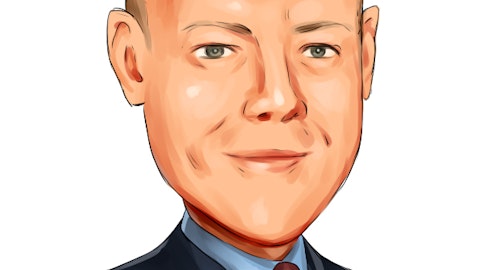Spiro Dounis: Thanks, operator. Good morning team. Maybe to start with Southeast supply enhancement. Alan, you mentioned that being the largest EBITDA contribution I think you said we’ve ever seen, which at least for us was maybe something we didn’t appreciate. So curious if you maybe just provide a sense of how you think about the capital costs, maybe even the returns around the two phases of that project. And also if you could maybe just talk about some of the physical capacity at 165 today to handle volumes when MVP comes online. I know it’s something you’ve addressed in the past, but still seems like some level of confusion there.
Alan Armstrong: Yes. Hey, Spiro. Thank you. Good morning and thanks for the great question. First of all, I want to clarify one thing, because it might have got confused a little bit in the commentary. When we talk about this potentially delivering another phase of expansion there, the EBITDA that I’m talking about and the scale of the EBITDA is on this initial phase. So we’re not counting on a second phase to grow that EBITDA to that kind of scale, just to be clear. So that EBITDA that I mentioned, being larger – being the largest and being larger than our entire Northwest Pipeline system is on the initial 1.4 Bcf/d for clarity on that topic. In terms of returns, we’re not going to put that number out there right now, but I can tell you, it’s one of the most attractive returns we’ve ever seen for any pipeline expansion of scale.
And we’re really excited that capacity is precious, coming out of there. And just to remind you on the physical capacities that we have out of there, the total physical capacity out of there is 5.7 Bcf/d, 2.5 to the north, 2.5 to the south, and 700 million a day on the Virginia lateral. So that’s the existing capacity that we have out of there, physical capacity that we have from 165 today. Obviously, there’s a lot of demand for that and capacity, and so it’s not like it’s just sitting there available for somebody to come in and buy. And that’s obviously why we’re able to put together such an attractive project here. Utilizing – by the way, utilizing our existing right away and obviously structuring that in a way that will be provide the least points of resistance from a permitting standpoint for expansion south on that.
So actually not a terribly complicated project. Easy for me to say that I don’t have the responsibility for getting that done directly, but it is on our existing right away and avoids a lot of the typical area wetland problems that we get into and tend to snag the permitting process. So, great job by the team on working with our big customers out there of meeting their very urgent needs on this and providing a very attractive project. So couldn’t be prouder of the team and the way they’ve worked through this.
Spiro Dounis: Got it. Helpful color and appreciate the clarification on the EBIT contribution for that first phase. Second question, maybe just turning to these two DJ Basin acquisitions, sounds like downstream benefits also drove part of the decision to expand there. So two questions on that front. One, does that 7x blended multiple impute any downstream benefits or is that sort of standalone for the assets? And then two, how should we think about the Cureton NGL volumes coming onto the downstream system? Is that something that happens immediately or do we need to wait for contracts to roll off.
Alan Armstrong: Spiro, I’m going to have Chad Zamarin take that.
Chad Zamarin: Yes. Thanks, Spiro. So that 7x multiple really reflects the standalone acquisition value and we do see significant opportunities to integrate those assets. It will take a little bit of time as there are some current commitments, but Cureton has more volume that they’re gathering than they can process and deliver into downstream infrastructure. And Rocky Mountain Midstream has some excess capacity. So we’re going to be able to consolidate those volumes and move a significant amount of incremental NGLs down our infrastructure. But there are some dedications over the next 12 months and beyond that will roll off and that will allow us to move those volumes fully over to our system, so you’ll see that value increase over time.
Spiro Dounis: Got it. Helpful color. Thanks, Chad. Thanks everybody.
Chad Zamarin: Thank you.
Operator: Thank you. We’ll go next now to Neel Mitra at Bank of America.
Neel Mitra: Hi, good morning. Thanks for taking my question. First on a macro level, it seems like some of the Southern Utilities are worried about having gas supply, especially with a lot of the Haynesville moving north to south with projects like your LEGpipeline. Are you seeing interest from Southeast customers rather Southern Utilitiesto move Haynesville gas on Transco towards that area?
Alan Armstrong: Yes, it’s a great question actually. And I think the market will figure that out. I think the way, for instance, our LEG project is structured, that will give people the opportunity as they come in there at [indiscernible] that’ll give Haynesville producers the options of either moving down the traditional path on Transco towards 85 and into those markets or selling into LNG, whichever their preference is. And so that’s the beauty of the Transco system is it gives people those options and the networking effect of our entire system gives people greater market options that they’ll appreciate. So I’m not sure that people will have that a producer, for instance, will have to declare one way or the other on that as much as they’ll be positioned to enjoy the benefits of either one of those markets.




